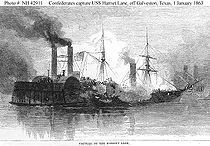
C.S. Bayou City
Encyclopedia

Steamboat
A steamboat or steamship, sometimes called a steamer, is a ship in which the primary method of propulsion is steam power, typically driving propellers or paddlewheels...
built for commercial use at Jeffersonville, Indiana
Jeffersonville, Indiana
Jeffersonville is a city in Clark County, Indiana, along the Ohio River. Locally, the city is often referred to by the abbreviated name Jeff. It is directly across the Ohio River to the north of Louisville, Kentucky along I-65. The population was 44,953 at the 2010 census...
, in 1859.
Serving as a mail boat
Mail steamer
Mail steamers were steamships which carried the mail across waterways, such as across an ocean or between islands, primarily during the 19th Century and early 20th Century, when the cost of sending a letter was declining to the point an ordinary person could afford the cost of sending a letter...
between Galveston and Houston, Texas, the ship was chartered on 26 September 1861 by Comdr. W. Hunter, CSN, commanding the Texas Marine Department
Marine Department
The Marine Department of the Hong Kong Government is responsible for maintaining safety and environmental protection of the harbour , ships registered/foreign ships in Hong Kong and monitor shipping traffic in Hong Kong Waters, search and rescue operations for large waters of the South China...
, from the Houston Navigation Co.
Military use
The Bayou City was clad with pressed cotton for protection, armed with artillery and operated by the State of Texas as a gunboatGunboat
A gunboat is a naval watercraft designed for the express purpose of carrying one or more guns to bombard coastal targets, as opposed to those military craft designed for naval warfare, or for ferrying troops or supplies.-History:...
in the Galveston area. Just over a year after its charter, in October 1862, she was taken over by the Confederate States Army
Confederate States Army
The Confederate States Army was the army of the Confederate States of America while the Confederacy existed during the American Civil War. On February 8, 1861, delegates from the seven Deep South states which had already declared their secession from the United States of America adopted the...
.
The Battle of Galveston
On 1 January 1863, in what would come to be known as the Battle of GalvestonBattle of Galveston
The Battle of Galveston or the Second Battle of Galveston was a naval and land battle that occurred on January 1, 1863, during the American Civil War when Confederate forces under Maj. Gen. John B...
, the cotton-clad
Cotton-clad
Cottonclads were a classification of steam-powered warships where a wooden ship was protected from enemy fire by bales of cotton lining its sides. This provided some protection from enemy fire, but not to the extent of ironclads...
Bayou City and the tugboat
Tugboat
A tugboat is a boat that maneuvers vessels by pushing or towing them. Tugs move vessels that either should not move themselves, such as ships in a crowded harbor or a narrow canal,or those that cannot move by themselves, such as barges, disabled ships, or oil platforms. Tugboats are powerful for...
were used by Confederate troop
Troop
A troop is a military unit, originally a small force of cavalry, subordinate to a squadron and headed by the troop leader. In many armies a troop is the equivalent unit to the infantry section or platoon...
s in an operation to drive Union
Union Navy
The Union Navy is the label applied to the United States Navy during the American Civil War, to contrast it from its direct opponent, the Confederate States Navy...
warships out of Galveston Bay
Galveston Bay
Galveston Bay is a large estuary located along the upper coast of Texas in the United States. It is connected to the Gulf of Mexico and is surrounded by sub-tropic marshes and prairies on the mainland. The water in the Bay is a complex mixture of sea water and fresh water which supports a wide...
.
After a brief contest at sea, the sank the Neptune, and one-half of the two-vessel Confederate fleet was lying on the bottom of the harbor. As the lone surviving Rebel steamer, the Bayou City was outnumbered six-to-one among the armed vessels in the harbor.
However, the Bayou City circled around and made a second run on the USS Harriet Lane. This time, the Confederates hit their target. In short order, the crew of the Bayou City succeeded in storming and overpowering the crew of the Lane. The men from the Bayou City boarded and seized the federal vessel despite the explosion of their own heavy cannon. Ultimately, the attack was a success, with the Harriet Lane captured and another Union vessel, the destroyed.
Continued service
Following the Battle of Galveston, Bayou City served the Confederacy in Texas waters until the conclusion of the American Civil WarAmerican Civil War
The American Civil War was a civil war fought in the United States of America. In response to the election of Abraham Lincoln as President of the United States, 11 southern slave states declared their secession from the United States and formed the Confederate States of America ; the other 25...
.

